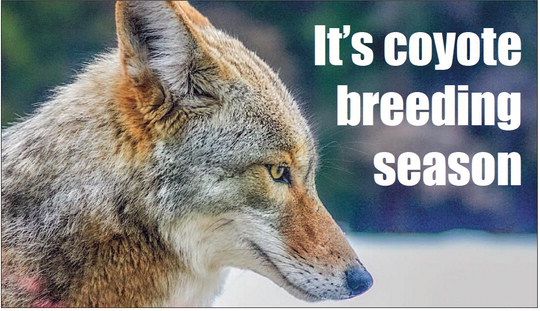It’s coyote breeding season


GUARD SMALL PETS
Coyote sightings are up around Leisure World
Coyote sightings are on the rise in almost every Mutual in Leisure World. There is a reason why. It’s whelping season.
Coyote breeding typically peaks in late February and March, and the gestation period averages 58 to 63 days. Male coyotes can become more aggressive during this time of year. The long and short of it all is that coyotes always pose a risk to small pets, and that risk increases during mating season.
Young are born March through May, with litter sizes averaging 5-6 pups. Coyotes produce one litter per year.
So coyotes are on the prowl for food and water. It used to be that coyotes could mostly be seen at dusk and dawn slinking along in the shadows. But lately they are everywhere, at all hours and in almost all Mutuals., according to residents who call Security and post on Facebook and Nextdoor.
Coyotes typically skulk away at the first sign of a human, but there have been reports of more brazen behavior. Coyotes can be seen making their way through carports, peering in patios and loping through greenbelts.
The animals typically winter in dens until spring when they emerge to hunt. Their primary food is rodents, squirrels and rabbits, but they will eat almost anything, including fruit, grass and vegetables. They take advantage of whatever is available, including garbage, pet food and domestic animals.
Animal control experts recommend that residents follow these precautions to keep the coyotes away from neighbor- hoods:
•Close the lids of community garbage containers after trash is placed inside.
•Do not leave pet food or water in patio areas. Put away bird feeders at night to avoid attracting rodents and other coyote prey.
•Be aware of surroundings while walking dogs in the evening and early morning hours. Loud noises will scare off the animals, which are typically frightened of humans and run from conflict.
•Don’t leave doors or windows open.
If food and water are removed, and people haze coyotes, the animals will move on to morehospitablelocales. Hazing uses scare tactics to reinstill fear of humans. Hazing techniques include:
•Yell and wave your arms while approaching a coyote.
•Use noisemaker such as whistles, air horns, bells or soda cans filled with pennies.
•Use projectiles such as sticks, small rocks, cans, tennis balls or rubber balls to throw at the coyote.
Never approach a sick, injured or cornered coyote.
For animal control services or to report stray, aggressive or dead animals, call Seal Beach Police Dispatch at 562-5947232.
For more information on animal control, call 562-7994100, ext. 1606, or email animalcontrol@ sealbeachca.gov. It is a violation of state law to feed wildlife because it alters their natural behaviors.

Coyote sightings are on the rise as whelping season is underway.Ruth Osborn


